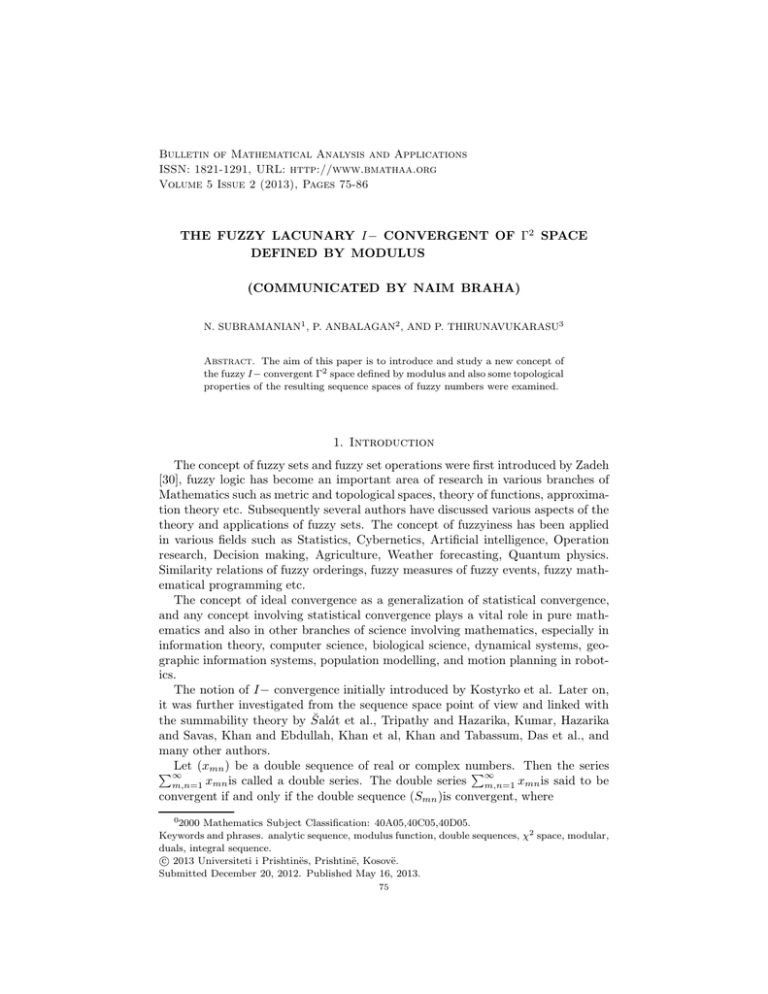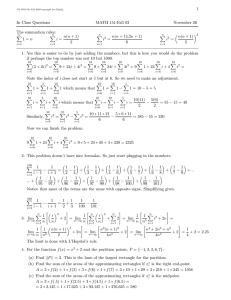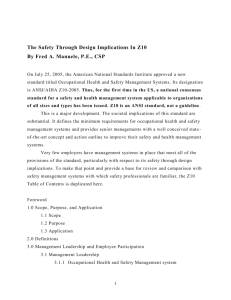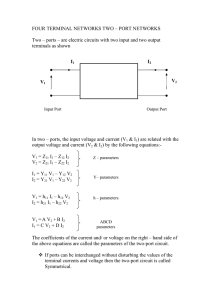Bulletin of Mathematical Analysis and Applications ISSN: 1821-1291, URL:
advertisement

Bulletin of Mathematical Analysis and Applications
ISSN: 1821-1291, URL: http://www.bmathaa.org
Volume 5 Issue 2 (2013), Pages 75-86
THE FUZZY LACUNARY I− CONVERGENT OF Γ2 SPACE
DEFINED BY MODULUS
(COMMUNICATED BY NAIM BRAHA)
N. SUBRAMANIAN1 , P. ANBALAGAN2 , AND P. THIRUNAVUKARASU3
Abstract. The aim of this paper is to introduce and study a new concept of
the fuzzy I− convergent Γ2 space defined by modulus and also some topological
properties of the resulting sequence spaces of fuzzy numbers were examined.
1. Introduction
The concept of fuzzy sets and fuzzy set operations were first introduced by Zadeh
[30], fuzzy logic has become an important area of research in various branches of
Mathematics such as metric and topological spaces, theory of functions, approximation theory etc. Subsequently several authors have discussed various aspects of the
theory and applications of fuzzy sets. The concept of fuzzyiness has been applied
in various fields such as Statistics, Cybernetics, Artificial intelligence, Operation
research, Decision making, Agriculture, Weather forecasting, Quantum physics.
Similarity relations of fuzzy orderings, fuzzy measures of fuzzy events, fuzzy mathematical programming etc.
The concept of ideal convergence as a generalization of statistical convergence,
and any concept involving statistical convergence plays a vital role in pure mathematics and also in other branches of science involving mathematics, especially in
information theory, computer science, biological science, dynamical systems, geographic information systems, population modelling, and motion planning in robotics.
The notion of I− convergence initially introduced by Kostyrko et al. Later on,
it was further investigated from the sequence space point of view and linked with
the summability theory by S̆alát et al., Tripathy and Hazarika, Kumar, Hazarika
and Savas, Khan and Ebdullah, Khan et al, Khan and Tabassum, Das et al., and
many other authors.
Let (xmn ) be a double sequence of real or complex numbers.
Then the series
P∞
P∞
x
is
called
a
double
series.
The
double
series
x
mn
m,n=1
m,n=1 mn is said to be
convergent if and only if the double sequence (Smn )is convergent, where
0
2000 Mathematics Subject Classification: 40A05,40C05,40D05.
Keywords and phrases. analytic sequence, modulus function, double sequences, χ2 space, modular,
duals, integral sequence.
c 2013 Universiteti i Prishtinës, Prishtinë, Kosovë.
Submitted December 20, 2012. Published May 16, 2013.
75
76
N. SUBRAMANIAN, P. ANBALAGAN, AND P. THIRUNAVUKARASU
Smn =
2
Pm,n
i,j=1
xij (m, n = 1, 2, 3, ...) (see[1]).
We denote w as the class of all complex double sequences (xmn ). A sequence
x = (xmn )is said to be Pringsheim’s sense double analytic if
supmn |xmn |
1/m+n
< ∞.
The vector space of all Pringsheim’s sense double analytic sequences are usually
denoted by Λ2 . A sequence x = (xmn ) is called Pringsheim’s sense double entire
sequence if
|xmn |
1/m+n
→ 0 as m, n → ∞.
The vector space of all Pringsheim’s sense double entire sequences are usually denoted by Γ2 . The spaces Λ2 and Γ2 are metric space with the metric
o
n
1/m+n
: m, n : 1, 2, 3, ... ,
(1)
d(x, y) = supmn |xmn − ymn |
forall x = {xmn } and y = {ymn } in Γ2 .
Consider a double sequence x = (xij ). The (m, n)th section x[m,n] of the seP
quence is defined by x[m,n] = m,n
i,j=0 xij δij for all m, n ∈ N,
0, 0, ...0, 0, ...
0, 0, ...0, 0, ...
.
δmn = .
.
0, 0, ...1, 0, ...
0, 0, ...0, 0, ...
with 1 in the (m, n)th position and zero other wise. An FK-space(or a metric
space)X is said to have AK property if (δmn ) is a Schauder basis for X. Or equivalently x[m,n] → x under metric. We need the following inequality in the sequel of
the paper:
Lemma 1: For a, b ≥ 0 and 0 < p < 1, we have
(a + b)p ≤ ap + bp
Some initial works on double sequence spaces is found in Bromwich[4]. Later
on it was investigated by Hardy[9], Moricz[17], Moricz and Rhoades[18], Basarir
and Solankan[2], Tripathy[26], Colak and Turkmenoglu[6], Turkmenoglu[28], and
many others. Tripathy and Dutta [31], introduced and investigated different types
of fuzzy real valued double sequence spaces. Generalizing the concept of ordinary
convergence for real sequences Kostyrko et al. [9] introduced the concept of ideal
convergence which is a generalization of statistical convergence, by using the ideal
I of the subsets of the set of natural numbers.
Throughout the article Λ2 , Γ2 denote the spaces of Pringsheim’s double analytic
2I
and Pringsheim’s double entire sequences respectively and Λ2I
F and ΓF denote the
classes of I− analytic and I− entire fuzzy real valued double sequences respectively.
The notion of difference sequence spaces (for single sequences) was introduced
by Kizmaz [14] as follows
Z (∆) = {x = (xk ) ∈ w : (∆xk ) ∈ Z}
THE FUZZY LACUNARY I− CONVERGENT OF Γ2 SPACE DEFINED BY MODULUS
77
for Z = c, c0 and ℓ∞ , where ∆xk = xk − xk+1 for all k ∈ N. Here w, c, c0 and ℓ∞
denote the classes of all, convergent,null and bounded scalar valued single sequences
respectively. The above spaces are Banach spaces normed by
kxk = |x1 | + supk≥1 |∆xk |
Later on the notion was further investigated by many others. We now introduce
the following difference double sequence spaces defined by
Z (∆) = x = (xmn ) ∈ w2 : (∆xmn ) ∈ Z
where Z = Λ2 and Γ2 . respetively. ∆xmn = (xmn − xmn+1 )−(xm+1n − xm+1n+1 ) =
xmn − xmn+1 − xm+1n + xm+1n+1 for all m, n ∈ N. Further generalized this notion
and introduced the following notion. For m, n ≥ 1,
Z ∆µγ = x = (xmn : ∆µγ xmn ∈ Z for Z = Λ2 and Γ2
An Orlicz function is a function M : [0, ∞) → [0, ∞) which is continuous, nondecreasing and convex with M (0) = 0, M (x) > 0, for x > 0 and M (x) → ∞ as
x → ∞. If convexity of Orlicz function M is replaced by M (x + y) ≤ M (x)+M (y) ,
then this function is called modulus function.
Remark 1:An Modulus function satisfies the inequality M (λx) ≤ λM (x) for all λ
with 0 < λ < 1.
In this article are introduce fuzzy I− convergent Γ2∆ space defined by Modulus function.
2. Definitions and Preliminaries
Let µ = (λmn ) be a sequence of non-zero scalars. Then for a given sequence
space E, the multiplier sequence space E (µ) associated with multiplier sequence µ
is defined by
E (µ) = {x = (xmn ) : (λmn xmn ) ∈ E}
X
Let X be a non empty set. A non-void class
S I ⊆ 2 (power set, of X) is called
an ideal if I is additive (i.e A, B ∈ I ⇒ A B ∈ I) and hereditary (i.e A ∈ I and
B ⊆ A ⇒ B ∈ I). A non-empty
family of sets F ⊆ 2X is said to be a filter on X if
T
φ∈
/ F ; A, B ∈ F ⇒ A B ∈ F and A ∈ F, A ⊆ B ⇒ B ∈ F. For each ideal I there
is a filter F (I) given by F (I) = {K ⊆ N : N \ K ∈ I} .
Throughout the ideals of 2N and 2N ×N will be denoted by I and I2 respectively.
A fuzzy real number X is a fuzzy set on R, a mapping X : R → L (= [0, 1])
associating each real number t with its grade of membership X (t) . The α− level
α
α
set of a fuzzy real number X, 0 < α < 1 denoted by [X] is defined as [X] =
{t ∈ R : X (t) ≥ α} . A fuzzy real number X is called convex if X (t) ≥ X (s) ∧
X (r) = min (X (s) , X (r)) , where s < t < r. If there exists t0 ∈ R such that
X (t0 ) = 1, then the fuzzy real number X is called normal. A fuzzy real X is said
to be upper semi-continuous if for each ǫ > 0, X −1 ([0, a + ǫ)) , for all a ∈ L is open
in the usual topology of R. The set of all upper semi continuous, normal convex
fuzzy number is denoted by L (R) .
Throughout a fuzzy real valued double sequence is denoted by (Xmn ) i.e a double
infinite array of fuzzy real number Xmn for all m, n ∈ N.
Every real number r can express as a fuzzy real number r as follows:
1,
if t = r;
r=
0,
otherwise
78
N. SUBRAMANIAN, P. ANBALAGAN, AND P. THIRUNAVUKARASU
Let D be the set of all closed bounded intervals X = X L , X R . Then X ≤ Y if
R
R
and only if X L ≤ Y L and
LX ≤L Y . R
Also d (X, Y ) = max X − Y , X − Y R . Then (D, d) is a complete metric
space.
Let d : L (R) × L (R) → R be defined by
α
α
d (X, Y ) = sup0≤α≤1 d ([X] , [Y ] ) for X, Y ∈ L (R) .
Then d defined a metric on L (R) .
By a lacunary sequence θ = (mn)rs , where
0, 0, ...0,
0, 0, ...0,
.
(mn)00 =
.
.
0, 0, ...0,
0, 0, ...0,
0, ...
0, ...
,
0, ...
0, ...
we shall mean an increasing sequence of non-negative integers with (mn)rs −
(mn)r−1,s−1 → ∞ as r, s → ∞. The intervals determined by θ will be denoted
i
by Irs = (mn)r−1,s−1 , (mn)rs and we let hrs = (mn)rs − (mn)r−1,s−1 . The
space of lacunary strongly entire sequences Nθ is defined as follows:
o
n
P
P
1/m+n
= 0, as r, s → ∞
Nθ = x = (xrs ) : h1rs m∈Irs n∈Irs |xmn − 0|
2.1. Definition. Let A denote a four dimensional summability method that maps
the complex double sequences x into the double sequence. Ax where the mn − th
term to Ax is as follows
P
P∞ mn
(Ax)k,ℓ = ∞
m=1
n=1 akℓ xmn .
In [10] Hardy presented the notion of regularity of two dimensional matrix transformations. The definition is as follows: a two dimensional matrix transformation is
said to be regular if it maps every convergent sequence into a convergent sequence
with the same limit. In addition, to the numerous theorems characterizing regularity. Hardy also presented the Silvermann-Toeplitz characterization of regularity following this work Robison in 1926 presented a four dimensional analog of regularity
for double sequences in which he added an additional assumption of boundedness.
This assumption was made because a double sequence which is P −convergent is
not necessarily bounded along these same lines, Robison and Hamiltion presented
a Silverman-Toeplitz type multidimensional characterization of regularity in [11]
and [25]. The definition of regularity for four dimensional matrices will be stated
next, followed by the Robison-Hamilton characterization of the regularity of four
dimensional matrices.
2.2. Definition. A double sequences (Xmn ) is said to be convergent in Pringsheim’s sense to the fuzzy real number X, if for every ǫ > 0, there exists n0 =
n0 (ǫ) , k0 = k0 (ǫ) ∈ N such that d (Xmn , X) < ǫ for all n ≥ n0 , k ≥ k0 .
2.3. Definition. A double sequence(Xmn ) is said to be I−convergent
to the fuzzy
number X0 , if for all ǫ > 0, the set (n, k) ∈ N 2 : d (Xmn , X0 ) ≥ ǫ ∈ I. We write
I − limXmn = X0 .
THE FUZZY LACUNARY I− CONVERGENT OF Γ2 SPACE DEFINED BY MODULUS
79
2.4. Definition. A double sequence E F is said to be monotone if E F contains the
canonical pre-image of all its step spaces.
2.5. Definition. A double sequence E F is said to be symmetric if Xπ(m),π(n) ∈
E F , whenever (Xmn ) ∈ E F , where π is a permutation of N × N.
2.6. Definition. A double sequence E F is said to be sequence algebra if (Xmn ⊗ Ymn ) ∈
E F , whenever (Xmn ) , (Ymn ) ∈ E F .
2.7. Definition. A double sequence E F is said to be convergence free if (Ymn ) ∈
E F , whenever (Xmn ) ∈ E F and Xmn = 0 implies Ymn = 0.
The notion of the statistical convergence was introduced by H. Fast. Later on
it was studied by J.A.Fridy from the sequence space point of view and linked it
with the summability theory.
The notion of I-convergence is a generalization of the statistical convergence. At
the initial stage it was studied by Kostyrko, S̆alát and Wilezyński. Later on it was
studied by Šalát, Tripathy and Ziman and Demirci, Das, Kostyrko, Wilczynski,
and Malik, Mursaleen and Alotaibi, Mursaleen, Mohiuddine and Edely, Mursaleen
and Mohiuddine, Sahiner, Gurdal, Saltan and Gunawan and Kumar, V.A.Khan,
Suthep suantai and Khalid Ebadullah. Here we give some preliminaries about the
notion of I− convergence.
Let X be a non empty set. Then a family of sets I S
⊆ 2X ( power set of X) is
said to be an ideal if I is additive i.e A, B ∈ I ⇒ A B ∈ I and hereditary i.e
A ∈ I, B ⊆ A ⇒ B ∈ I.
A non-empty family of sets L (I) ⊆ 2XT is said to be filter on X if and only if
Φ∈
/ L (I) , for A, B ∈ L (I) we have A B ∈ L (I) and for each A ∈ L (I) , A ⊆
B ⇒ B ∈ L (I) .
An ideal I ⊆ 2X is called non-trivial if I 6= 2X .
A non-trivial ideal I ⊆ 2X is called admissible if {{x} : x ∈ X} ⊆ I
A non-trivial ideal I is maximal if there cannot exist any non-trivial ideal J 6= I
containing I as a subset.
For each ideal I, there is a filter L (I) corresponding to I. i.e L (I) = {K ⊆ N : K c ∈ I} ,
where K c = N − K.
3. Double entire sequence space of fuzzy numers
This paper to introduce the following sequence spaces and examine topological
and algebraic properties of the resulting sequence spaces. Let I be an admissible
ideal of N and let p = (pmn ) be a sequence of positive real numbers for all m, n ∈ N.
Let θ = (mn)rs be a lacunary sequence, f be an modulus function, µ = (λmn ) be
a sequence of non-zero scalars and X = (Xmn ) be a sequence of fuzzy numbers, we
define the following sequence spaces as:
h ipmn
o
n
P
P
2I(F )
1/m+n
,0
≥ǫ ∈
Γθ,f,µ,p = (r, s) ∈ N : h1rs m∈Irs n∈Irs f d (λmn Xmn )
80
N. SUBRAMANIAN, P. ANBALAGAN, AND P. THIRUNAVUKARASU
I,
n
2I(F )
Λθ,f,µ,p = (r, s) ∈ N :
I,
1
hrs
P
m∈Irs
P
ipmn
o
h 1/m+n
d
(λ
X
)
,
0
≥
K
∈
f
mn mn
n∈Irs
and
h ipmn
n
o
P
1/m+n
1 P
f
d
(λ
X
)
,
0
=
sup
Λ2F
<
∞
.
mn
mn
rs
θ,f,µ,p
n∈Irs
m∈Irs
hrs
Some classes are obtained by specializing θ = (mn)rs , f, µ = (λmn ) and p = (pmn ) :
(i)If θ = (mn)rs = (2rs ) , then we obtain
n
o
ipmn
Pr
Ps h 2I(F )
1/m+n
1
(λ
X
)
,
Γf,µ,p = (r, s) ∈ N : rs
≥
ǫ
∈ I,
f
d
0
mn mn
m=1
n=1
ipmn
o
n
Pr
Ps h 2I(F )
1/m+n
1
≥K ∈
Λf,µ,p = (r, s) ∈ N : rs
,0
m=1
n=1 f d (λmn Xmn )
I,
and
n
o
ipmn
Ps h Pr
1/m+n
1
f
Λ2F
=
sup
<
∞
.
d
(λ
X
)
,
0
rs rs
mn mn
f,µ,p
n=1
m=1
(ii) If f (x) = x, then we obtain,
h n
ipmn
o
P
P
2I(F )
1/m+n
Γθ,µ,p = (r, s) ∈ N : h1rs m∈Irs n∈Irs d (λmn Xmn )
,0
≥ǫ ∈
I,
ipmn
o
h n
P
P
2I(F )
1/m+n
,0
≥K ∈
Λθ,µ,p = (r, s) ∈ N : h1rs m∈Irs n∈Irs d (λmn Xmn )
I,
and
ipmn
n
o
h P
1/m+n
1 P
d
0
Λ2F
=
sup
<
∞
.
(λ
X
)
,
rs
mn
mn
θ,µ,p
n∈Irs
m∈Irs
hrs
1, 1, ...1, 1, ...
1, 1, ...1, 1, ...
.
, then we obtain
.
(iii)If µ = (λmn ) =
.
1, 1, ...1, 1, ...
1, 1, ...1, 1, ...
h n
ipmn
o
P
P
2I(F )
1/m+n
Γθ,f,p = (r, s) ∈ N : h1rs m∈Irs n∈Irs f d (Xmn )
,0
≥ ǫ ∈ I,
o
ipmn
n
h P
P
2I(F )
1/m+n
≥K ∈
,0
Λθ,f,p = (r, s) ∈ N : h1rs m∈Irs n∈Irs f d (Xmn )
I,
THE FUZZY LACUNARY I− CONVERGENT OF Γ2 SPACE DEFINED BY MODULUS
81
and
ipmn
o
h n
P
1/m+n
1 P
d
(X
)
,
0
<
∞
.
f
Λ2F
=
sup
mn
rs hrs
θ,f,p
n∈Irs
m∈Irs
1, 1, ...1, 1, ...
1, 1, ...1, 1, ...
.
, then we obtain
(iv) If p = (pmn ) = .
.
1, 1, ...1, 1, ...
1, 1, ...1, 1, ...
h n
i
o
P
P
2I(F )
Γθ,f,µ = (r, s) ∈ N : h1rs m∈Irs n∈Irs f d (λmn Xmn )1/m+n , 0
≥ ǫ ∈ I,
i
o
h n
P
P
2I(F )
1/m+n
≥K ∈
Λθ,f,µ = (r, s) ∈ N : h1rs m∈Irs n∈Irs f d (λmn Xmn )
,0
I,
and
h n
i
o
P
P
1/m+n
1
Λ2F
,0
<∞ .
θ,f,µ = suprs hrs
n∈Irs f d (λmn Xmn )
m∈Irs
4. Main Results
In this section we examine the basic topological and algebraic properties of these
spaces and obtain the inclusion relation between these spaces.
2I(F )
2I(F )
4.1. Theorem. Γθ,f,µ,p and Λθ,f,µ,p are linear spaces
Proof: It is routine verification. Therefore we omit the proof.
2(F )
4.2. Theorem. The space Λθ,f,µ,p is a paranormed space (not totally paranormed)
with the paranorm gµ defined by
h n
ipmn
o
1/m+n
gµ (X) = inf supmn f d (λmn Xmn )
,0
≤1 .
0, 0, ...0, 0, ...
0, 0, ...0, 0, ...
.
.
.
Proof:Clearly gµ (−X) = gµ (X) and gµ (θ) =
.
0, 0, ...0, 0, ...
0, 0, ...0, 0, ...
2(F )
Let X = (Xmn ) and Y = (Ymn ) be two elements in Λθ,f,µ,p . Then
i
o
h n
≤1
A1 = inf supmn f d (λmn Xmn )1/m+n , 0
and
h n
i
o
1/m+n
A2 = inf supmn f d (λmn Ymn )
,0
≤1
We
the following
h obtain
i h i
1/m+n
1/m+n
f d (λmn (Xmn + Ymn ))
,0
≤ f d (λmn Xmn )
,0
+
i
h 1/m+n
,0
.
f d (λmn Ymn )
82
N. SUBRAMANIAN, P. ANBALAGAN, AND P. THIRUNAVUKARASU
Thus we have
and
ipmn
h 1/m+n
≤1
,0
supmn f d (λmn (Xmn + Ymn ))
gµ (X + Y ) = inf {A1 } + inf {A2 } = gµ (X) + gµ (Y ) .
Let tmn → t where tmn , t ∈ C and let gµ (Xmn − X) → 0 as m, n → ∞. To prove
that gµ (tmn Xmn − tX) → 0 as m, n → ∞. By the continuity of the function f we
hobserve
that
i h i
1/m+n
1/m+n
,0
f d (λmn (tmn Xmn − tX))
≤ f d (λmn (tmn Xmn − tXmn ))
,0
+
i h i
h 1/m+n
1/m+n
,0
≤ f d (λmn Xmn )
,0
+
f d (λmn (tXmn − tX))
i
h 1/m+n
.
f d (λmn Ymn )
,0
From the above inequality it follows that
h ipmn
1/m+n
supmn f d (λmn (tmn Xmn − tX))
≤1
,0
and consequently
gµ (tmn Xmn − tX) ≤ |tmn − t| inf {A1 } + |t| inf {A2 }
gµ (tmn Xmn − tX) ≤ max {1, |tmn − t|} gµ (Xmn ) + max {1, |t|} gµ (Xmn − X) .
(2)
Therefore the above equation (4.1) implies that gµ (Xmn ) ≤ gµ (X)+gµ (Xmn + X)
for all m, n ∈ N. Hence by our assumption the right hand side of the relation (4.1)
tens to 0 as m, n → ∞. This completes the proof.
4.3. Theorem. Let f and g be modulus functions. Then the following hold:
2I(F )
2I(F )
(i) Γθ,g,µ,p ⊆ Γθ,f,µ,p , provided p = (pmn ) be such that G0 = inf pmn > 0.
T
2I(F )
2I(F )
2I(F )
(ii) Γθ,f,µ,p Γθ,g,µ,p ⊆ Γθ,f +g,µ,p
o
n
G0
< ǫ.
Proof: (i) Let ǫ > 0 be given. Choose ǫ1 > 0 such that max ǫG
1 , ǫ1
Choose 0 < δ < 1 such that 0 < t < δ implies that f (t) < ǫ1 . Let X = (Xmn ) be
2I(F )
any element in Γθ,g,µ,p . Put
n
h o
ipmn
P
P
Aδ = (r, s) ∈ N : h1rs m∈Irs n∈Irs g d (λmn Xmn )1/m+n , 0
≥ δG ∈
I.
ipmn
h P
P
< δG
⇒ h1rs m∈Irs n∈Irs g d (λmn Xmn )1/m+n , 0
h ipmn
P
P
1/m+n
⇒ m∈Irs n∈Irs g d (λmn Xmn )
,0
< hrs δ G
ipmn
h 1/m+n
< δ G , ∀m, n ∈ Irs
⇒ g d (λmn Xmn )
,0
h i
1/m+n
⇒ g d (λmn Xmn )
,0
< δ G , ∀m, n ∈ Irs .
(3)
Using the continuity of the function f from the relation (4.2) we have
i
h 1/m+n
,0
< ǫ1 , ∀m, n ∈ Irs
f g d (λmn Xmn )
THE FUZZY LACUNARY I− CONVERGENT OF Γ2 SPACE DEFINED BY MODULUS
83
Consequently weh get
n
iipmn
o
h P
P
1/m+n
G0
< hrs · max ǫG
,0
<
g d (λmn Xmn )
1 , ǫ1
n∈Irs f
m∈Irs
hrs ǫ
h h iipmn
P
P
⇒ h1rs m∈Irs n∈Irs f g d (λmn Xmn )1/m+n , 0
< ǫ.
This implies that
h h iipmn
o
n
P
P
≥ ǫ ⊆ Aδ ∈
(r, s) ∈ N : h1rs m∈Irs n∈Irs f g d (λmn Xmn )1/m+n , 0
I.
2I(F ) T 2I(F )
(ii) Let X = (Xmn ) ∈ Γθ,f,µ,p Γθ,g,µ,p . Then by the following inequality the
result follows:
ipmn
h
P
1/m+n
1 P
d
(λ
X
)
,
0
≤
(f
+
g)
mn
mn
n∈I
m∈I
hrs
rs
rs
h ipmn
P
P
1/m+n
H h1rs m∈Irs n∈Irs f d (λmn Xmn )
,0
+
h ipmn
P
P
1/m+n
1
H hrs m∈Irs n∈Irs g d (λmn Xmn )
,0
. This completes the proof.
4.4. Theorem. Let 0 < pmn ≤ qmn and
then
qmn
pmn
2I(F )
is positive and bounded sequence,
2I(F )
Γθ,q,µ,p ⊆ Γθ,f,µ,p .
Proof: It is routine verification.. Therefore omit the proof.
4.5. Theorem. For any two sequences p = (pmn ) and q = (qmn ) of positive real
numbers, then the following holds:
2I(F ) T 2I(F )
(i) Γθ,f,µ,p Γθ,f,µ,q 6= φ;
2I(F ) T 2I(F )
(ii) Λθ,f,µ,p Λθ,f,µ,q 6= φ;
T 2F
(iii) Λ2F
Λθ,f,µ,q 6= φ.
θ,f,µ,p
4.6. Lemma. A sequence space EF is solid implies EF is monotone
4.7. Lemma. If I ⊂ 2N is a maximal ideal, then for each A ⊂ N we have either
A ∈ I or N − A ∈ I
2I(F )
2I(F )
4.8. Theorem. The sequence spaces Γθ,f,µ,p and Λθ,f,µ,p are solid as well as monotone
2I(F )
Proof: Let X = (Xmn ) ∈ Γθ,f,µ,p and Y = (Ymn ) be such that
1/m+n
1/m+n
d Ymn
, 0 ≤ d Xmn
, 0 for all m, n ∈ N. Then for given ǫ > 0 we have
h n
i
o
P
P
1/m+n
η = (r, s) ∈ N : h1rs m∈Irs n∈Irs f d (λmn Xmn )
,0
≥ǫ ∈I
h n
i
o
P
P
1/m+n
Again the set η = (r, s) ∈ N : h1rs m∈Irs n∈Irs f d (λmn Ymn )
,0
≥ǫ ⊆
2I(F )
2I(F )
η1 ∈ I and so Y = (Ymn ) Γθ,f,µ,p . Thus the space Γθ,f,µ,p is solid. From the Lemma
2I(F )
4.6, it follows that Γθ,f,µ,p is monotone.
84
N. SUBRAMANIAN, P. ANBALAGAN, AND P. THIRUNAVUKARASU
2I(F )
4.9. Result. If I is neither maximal nor then the space Γθ,f,µ,p is not symmetric
Proof: Let us consider a sequence X = (Xmn ) of fuzzy real numbers defined by
1 + t − 2t, if {t ∈ [2 (m + n) − 1, 2 (m + n)]} ;
1/m+n
Xmn
(t) = 1 − t + 2 (m + n) , if {t ∈ [2 (m + n) , 2 (m + n) + 1]} ;
0, otherwise.
2I(F )
for (m, n) ⊂ I an infinite set. Then (Xmn ) ∈ Γθ,f,µ,p . Let K ⊆ N be such that
K∈
/ I and N − K ∈
/ I (the set K exists by the Lemma 4.7, as I is not maximal).
Consider the sequence Y = (Ymn ) a rearrangement of the sequence (Xmn ) defined
as follows:
(
1/m+n
Xmn
, if m, n ∈ K;
1/m+n
Ymn
=
0, otherwise.
2I(F )
2I(F )
Then (Ymn ) ∈
/ Γθ,f,µ,p . Hence Γθ,f,µ,p is not symmetric.
2I(F )
4.10. Result. If I is neither maximal nor then the space Λθ,f,µ,p is not symmetric
Proof: Let us consider a sequence X = (Xmn ) of fuzzy real numbers defined by
1 + t − 3t, if {t ∈ [3 (m + n) − 1, 3 (m + n)]} ;
1/m+n
Xmn
(t) = 1 − t + 3 (m + n) , if {t ∈ [3 (m + n) , 3 (m + n) + 1]} ;
0, otherwise.
1/m+n
= 0.
for (m, n) ⊂ I an infinite set. Otherwise Xmn
Since I is not maximal, so by Lemma 4.7, there exists a subset K ∈ N such that
K ∈
/ I and N − K ∈
/ I. Let ζ : K → A and h : N − K → N − A be bijections.
Consider a sequence Y = (Ymn ) a rearrangement of the sequence (Xmn ) defined as
follows:
( 1/m+n
Xζ(mn) , if m, n ∈ K;
1/m+n
Ymn
=
1/m+n
Xh(mn) , otherwise.
2I(F )
2I(F )
Then (Ymn ) ∈
/ Λθ,f,µ,p . Hence Λθ,f,µ,p is not symmetric.
Acknowledgement: I wish to thank the referee’s for their several remarks and
valuable suggestions that improved the presentation of the paper.
References
[1] T.Apostol, Mathematical Analysis, Addison-wesley , London, 1978.
[2] M.Basarir and O.Solancan, On some double sequence spaces, J. Indian Acad.
Math., 21(2) (1999), 193-200.
[3] C.Bektas and Y.Altin, The sequence space ℓM (p, q, s) on seminormed spaces,
Indian J. Pure Appl. Math., 34(4) (2003), 529-534.
[4] T.J.I’A.Bromwich, An introduction to the theory of infinite series Macmillan
and Co.Ltd. ,New York, (1965).
[5] J.C.Burkill and H.Burkill, A Second Course in Mathematical Analysis Cambridge University Press, Cambridge, New York, (1980).
[6] R.Colak and A.Turkmenoglu, The double sequence spaces ℓ2∞ (p), c20 (p) and
c2 (p), (to appear). l
[7] K.Chandrasekhara Rao and N.Subramanian, The Orlicz space of entire sequences, Int. J. Math. Math. Sci., 68(2004), 3755-3764.
THE FUZZY LACUNARY I− CONVERGENT OF Γ2 SPACE DEFINED BY MODULUS
85
[8] M.Gupta and P.K.Kamthan,Infinite matrices and tensorial transformations,
Acta Math. , Vietnam 5 (1980), 33-42.
[9] G.H.Hardy, On the convergence of certain multiple series, Proc. Camb. Phil.
Soc., 19 (1917), 86-95.
[10] G.H.Hardy, Divergent Series, Oxford Univ. Press, London, 1949.
[11] H.J.Hamilton, Transformations of Multiple Sequences, Duke Math. Jour., 2
(1936), 29-60.
[12] M.A.Krasnoselskii and Y.B.Rutickii, Convex functions and Orlicz spaces,
Gorningen, Netherlands, 1961.
[13] P.K.Kamthan and M.Gupta, Sequence spaces and series, Lecture notes, Pure
and Applied Mathematics, 65 Marcel Dekker, In c., New York , 1981.
[14] H.Kizmaz, On certain sequence spaces, Canad Math. Bull. , 24(2)(1981), 169176.
[15] J.Lindenstrauss and L.Tzafriri, On Orlicz sequence spaces, Israel J. Math., 10
(1971), 379-390.
[16] I.J.Maddox, Sequence spaces defined by a modulus, Math. Proc. Cambridge
Philos. Soc, 100(1) (1986), 161-166.
[17] F.Moricz, Extentions of the spaces c and c0 from single to double sequences,
Acta. Math. Hungerica, 57(1-2), (1991), 129-136.
[18] F.Moricz and B.E.Rhoades, Almost convergence of double sequences and
strong regularity of summability matrices, Math. Proc. Camb. Phil. Soc., 104,
(1988), 283-294.
[19] M.Mursaleen,M.A.Khan and Qamaruddin, Difference sequence spaces defined
by Orlicz functions, Demonstratio Math. , Vol. XXXII (1999), 145-150.
[20] M.Mursaleen and M.Basarir, On some new sequence spaces of fuzzy numbers,
Indian J. Pure Appl. Math., 34(9) (2003), 1351-1357.
[21] H.Nakano, Concave modulars,
J. Math. Soc. Japan, 5(1953), 29-49.
[22] W.Orlicz, Ü ber Raume LM Bull. Int. Acad. Polon. Sci. A, (1936), 93-107.
[23] S.D.Parashar and B.Choudhary, Sequence spaces defined by Orlicz functions,
Indian J. Pure Appl. Math. , 25(4)(1994), 419-428.
[24] W.H.Ruckle, FK spaces in which the sequence of coordinate vectors is bounded,
Canad. J. Math., 25(1973), 973-978.
[25] G.M.Robison, Divergent Double sequences and Series, Amer. Math. Soc.
trans., 28 (1926), 50-73.
[26] B.C.Tripathy, On statistically convergent double sequences, Tamkang J.
Math., 34(3), (2003), 231-237.
[27] B.C.Tripathy,M.Et and Y.Altin, Generalized difference sequence spaces defined by Orlicz function in a locally convex space, J. Analysis and Applications,
1(3)(2003), 175-192.
[28] A.Turkmenoglu, Matrix transformation between some classes of double sequences, Jour. Inst. of math. and Comp. Sci. (Math. Seri. ), 12(1), (1999), 2331.
[29] A.Wilansky, Summability through Functional Analysis, North-Holland Mathematics Studies, North-Holland Publishing, Amsterdam, Vol.85(1984).
[30] L.A.Zadeh, Fuzzy sets, Inform Control, 8(1965), 338-353.
[31] B.C.Tripathyand A.J. Dutta, On fuzzy real valued double sequence spaces ,
Soochow J. Math., 32(4)(2006), 509-520.
86
N. SUBRAMANIAN, P. ANBALAGAN, AND P. THIRUNAVUKARASU
[32] A.Esi and B.Hazarika, Lacunary summable sequence spaces of fuzzy numbers defined by ideal convergence and an Orlicz function, African Mathematical
Union and Springer-Verlag Berlin Heidelberg, DOi 10. 1007/s13370-0120117-3, (2012).
1 Department
of Mathematics,
SASTRA University,
Thanjavur-613 401, India
E-mail address: nsmaths@yahoo.com
2
Department of Mathematics,
Government Arts College,
Trichy-620 022, India
E-mail address: anbalaganmaths@gmail.com
3
P.G. and Research Department of Mathematics,
Periyar E.V.R. College (Autonomous),
Tiruchirappalli–620 023, India.
E-mail address: ptavinash1967@gmail.com







